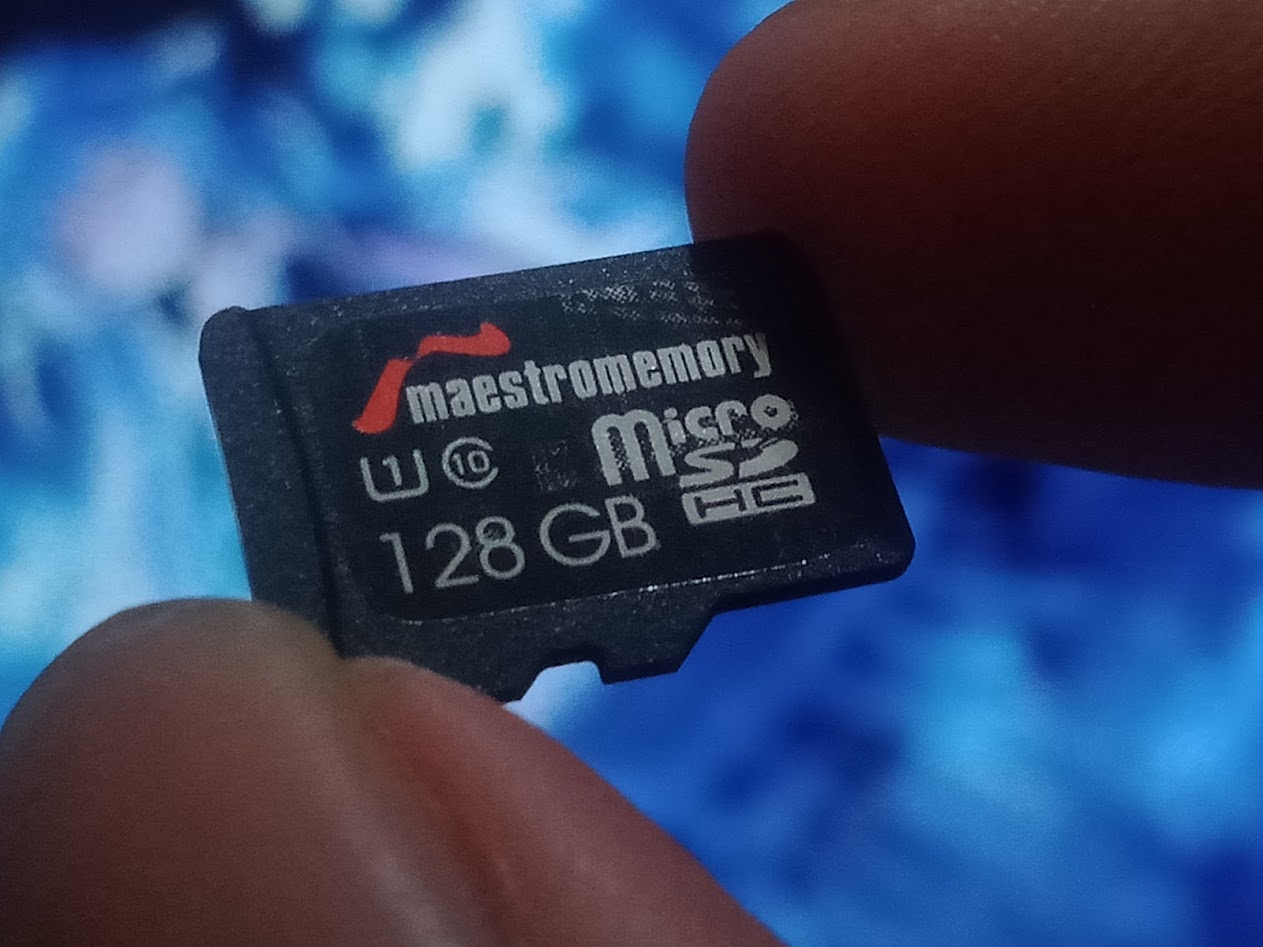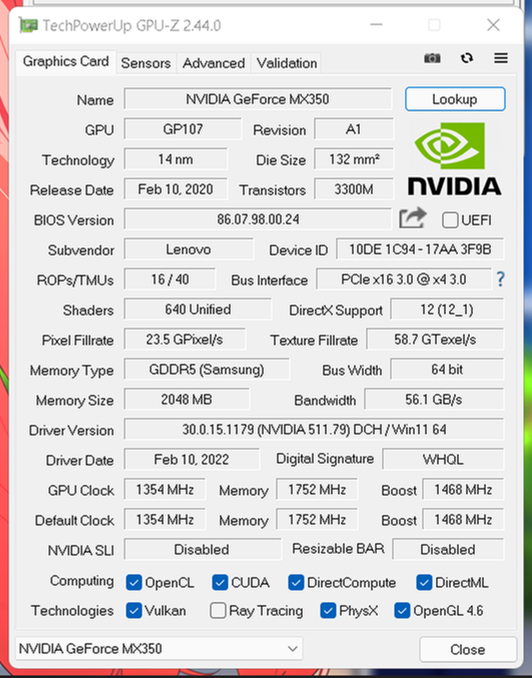Comparing: GeForce MX350 [Disk] vs Maestromemory MicroSDXC 128GB
In this comparison, we analyze two Disks: GeForce MX350 [Disk] and Maestromemory MicroSDXC 128GB, using synthetic benchmark tests to evaluate their overall performance. This side-by-side comparison helps users understand which hardware delivers better value, speed, and efficiency based on standardized testing. Whether you're building a new system or upgrading an existing one, this benchmark-driven evaluation offers valuable insights to guide your decision.

GeForce MX350 [Disk]
| Type: | Disks |
|---|---|
| Model: | GeForce MX350 [Disk] |
| Capacity: | 2GB, 1.5GB |
| Interface: | GDDR5 |

Maestromemory MicroSDXC 128GB
| Type: | Disks |
|---|---|
| Model: | Maestromemory MicroSDXC 128GB |
| Capacity: | 128GB |
| Interface: | UHS-I |
Specification Comparison Table
This specification comparison presents technical details of several devices or components to help you understand the key differences between each option. Use this table as a reference to determine which device best suits your needs.
| Specification | GeForce MX350 [Disk] | Maestromemory MicroSDXC 128GB |
|---|---|---|
| Brand | Samsung | Maestromemory |
| Format | VRAM Disk | MicroSDXC |
| Capacity | 2GB, 1.5GB | 128GB |
| Interface | GDDR5 | UHS-I |
Submission Comparison Table
This submission comparison table displays the number and details of benchmark data submissions from various devices or components. This information helps you understand the performance based on the benchmarks that have been tested, as well as providing an overview of the consistency and popularity of the available benchmark results.
| No. | Benchmark Software | GeForce MX350 [Disk] | Maestromemory MicroSDXC 128GB |
|---|---|---|---|
| 1 | ATTO Disk Benchmark - 64M |
Read: 1440.00 MB/s Write: 1330.00 MB/s |
Read: 92.09 MB/s Write: 45.47 MB/s |
| 2 | CrystalDiskMark |
Read: 1113.58 MB/s Write: 995.48 MB/s |
Read: 93.41 MB/s Write: 55.99 MB/s |
Submission Comparison Chart
This chart visualizes the benchmark scores comparison between two hardware devices based on submitted data.
Media Gallery
A collection of photos of tested hardware. These images can help you identify the physical form, model, and variant of the hardware in question. These photos are from our own documentation, and if they are not available we may not be able to document them.
About Hardware GeForce MX350 [Disk]
The NVIDIA GeForce MX350 is an entry-level GPU designed for thin and light laptops, delivering significant graphics performance improvements over the processor's built-in iGPU. The GPU is based on the Pascal architecture with 640 CUDA Cores, and features 2GB or 4GB of GDDR5 memory with 64-bit bus width. The MX350 is generally used for light graphics tasks such as photo editing, light video, and casual gaming, and provides GPU acceleration for CUDA-enabled creative applications.
But in this particular test, a portion of the video memory (VRAM) on the GeForce MX350 was configured as a VRAMDisk. The concept of a VRAMDisk is similar to a RAMDisk, but it uses the VRAM of the GPU as a super-fast storage medium. VRAMDisk allows the creation of temporary, high-speed drives that can be utilized for technical experiments, speed testing, or graphics caching in certain scenarios. Although its capacity is limited and volatile (data is lost on reboot), the high bandwidth and low latency of VRAM provide compelling performance in certain contexts.
The tests were conducted on a Lenovo IdeaPad Slim 3i 14ITL6 laptop with Intel Core i5-1135G7 processor, 12GB DDR4 3200MHz dual channel RAM, and Windows 11 22H2 operating system. The VRAMDisk was created from a 2GB GeForce MX350 GPU, with virtual disk sizes of 1GB and 1.5GB, using special software called GPU RAM Drive.
Benchmark results with CrystalDiskMark recorded read speeds of 1113.58 MB/s and write speeds of 995.48 MB/s, showing the high bandwidth potential of VRAM as a temporary storage medium. Although the performance does not match DDR4-based RAMDisks, VRAMDisks remain a unique and attractive solution for certain technical purposes, especially for users who want to utilize idle VRAM for fast I/O processes. With its dedicated laptop GPU form factor and PCIe x4 Gen 3.0 interface, the GeForce MX350 VRAMDisk opens up new exploration possibilities in the world of experimental graphics-based high-speed storage.
Device test (testbed):
Device: Lenovo IdeaPad Slim 3i 14ITL6
CPU: i5 1135G7
RAM: 12GB DDR4 3200MHz Dual Channel (8+4)
OS: Windows 11 22H2
Friday, 06 August 2021 04:34:19 | Update: 1 month ago
About Hardware Maestromemory MicroSDXC 128GB
MaestroMemory MicroSDXC 128GB is an affordable yet reliable external storage solution, designed for use in various devices such as smartphones, tablets, digital cameras, and laptops. Supported by UHS-I and Class 10 technology, this memory card offers high data transfer speeds to support multimedia needs such as video recording, storing high-resolution photos, and running mobile applications without any significant obstacles.
The large capacity of 128GB provides ample space to store important files such as work documents, music collections, and video content. In addition, MaestroMemory also emphasizes power efficiency and resistance to various environmental conditions, such as high and low temperatures, making it suitable for long-term use in various situations. The card is compatible with the exFAT file system which is the storage standard for modern devices, maximizing space usage and compatibility.
The test was conducted using a Lenovo IdeaPad Slim 3i 14ITL6 equipped with an Intel Core i5-1135G7 processor, NVIDIA MX350 GPU, and 12GB RAM, with Windows 11 Home 23H2 operating system. The tests were conducted through the USB 3.1 Gen 1 port using a VENTION USB 3.0 card reader with GL3224 controller, in a freshly opened card condition, with no files, and the default “Quick Removal” policy from Device Manager.
The benchmark results show quite competitive performance in its class. In tests using CrystalDiskMark, the 128GB MaestroMemory recorded read speeds of 93.41 MB/s and write speeds of 55.99 MB/s. Further testing with ATTO Disk Benchmark (64M) showed read speeds of 92.09 MB/s and write speeds of 45.47 MB/s, while Cross Platform Disk Test recorded speeds of 91.13 MB/s for read and 47.95 MB/s for write. These figures show that this microSD card is capable of meeting daily needs such as Full HD video recording, installation of large applications, or transferring large amounts of data.
However, it should be noted that we did not find any official information about the manufacturer of MaestroMemory, including the company's website or technical documentation that is usually found on reputable brands. We found this microSD card widely sold in the Indonesian marketplace, and based on discussions, there is speculation that MaestroMemory is a sub-brand of V-GeN Indonesia, although this claim has yet to be officially verified. If you try to search for MaestroMemory on international marketplaces, you will most likely not find it.
For additional validation, we also conducted a capacity integrity test using H2testw, and the results showed that the MaestroMemory 128GB microSD passed the test, with the correct capacity and no damaged areas or fake storage detected.
Overall, the MaestroMemory MicroSDXC 128GB is an attractive option for users looking for a large capacity memory card at a competitive price, as long as it is used in accordance with its class and segmentation. As a wise move, users are advised to always perform authenticity checks and post-purchase performance tests.
Device Test (Testbed):
Device: Lenovo IdeaPad Slim 3i 14ITL6
Device Specs: i5-1135G7, NVIDIA MX350, 12GB RAM 3200MHz (4+8), 512GB NVMe SSD, USB 3.1 Gen 1, Windows 11 Home 23H2
Card Reader: VENTION USB 3.0 (GL3224 Controller)
Room Temperature: 30 celcius based on DHT11 Sensors
Condition: This experiment is run when the item is newly purchased, no files condition (0% usage), exFAT file system (default), Device Manager Policy: Quick Removal (Default).
Friday, 23 February 2024 09:51:41 | Update: 1 month ago

